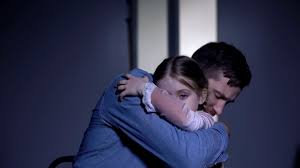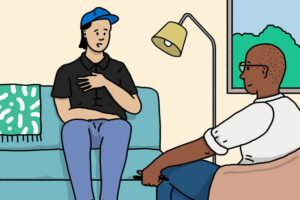It’s not easy to admit when you need help. This is especially true if you’re struggling with post-traumatic stress disorder (PTSD). It can be difficult to recognize the symptoms, and even more difficult to find the right treatment option for you. In this blog post, we will discuss 11 steps that can help you get the help you need for PTSD. We’ll talk about recognizing the symptoms, finding a therapist, and choosing the best treatment option for you.
Contents
How To Recognize Symptoms To Get PTSD Help?
 PTSD can cause a person to feel disconnected from the world around them. It is even possible to feel like you are outside of your own body looking in. Recognizing symptoms of PTSD is the first step to getting help. Symptoms can vary from person to person, but some common signs include:
PTSD can cause a person to feel disconnected from the world around them. It is even possible to feel like you are outside of your own body looking in. Recognizing symptoms of PTSD is the first step to getting help. Symptoms can vary from person to person, but some common signs include:
- Intrusive thoughts or memories of the traumatic event.
- Flashbacks or nightmares of the event.
- Avoidance of people, places, or things that serve as reminders of the trauma.
- Uncontrollable negative thoughts about oneself or others.
- Hopelessness about the future.
- Detachment from friends and family members.
- Loss of interest in activities that were once enjoyed.
- Irritability or aggression.
- Hypervigilance or always being on the lookout for danger.
- Feeling easily startled or scared.
- Difficulty sleeping or concentrating.
In fact, these symptoms of PTSD can be divided into three main categories:
- intrusive thoughts,
- avoidance,
- hyperarousal.
If you are experiencing any of these symptoms, it is important to seek help from a mental health professional. PTSD can be treated with a combination of medication and therapy.
How To Get PTSD Help?
 When you recognize the symptoms of PTSD in yourself or a loved one, it can be overwhelming. You may feel like you are alone and that no one understands what you are going through. The good news is that there are many resources available to help you manage your symptoms and get the treatment you need. So, here are 11 steps to get PTSD help in order to recover.
When you recognize the symptoms of PTSD in yourself or a loved one, it can be overwhelming. You may feel like you are alone and that no one understands what you are going through. The good news is that there are many resources available to help you manage your symptoms and get the treatment you need. So, here are 11 steps to get PTSD help in order to recover.
11 Steps To Get PTSD Help
There are many options available for getting help with PTSD. Here are 11 steps to get you started on the road to recovery:
Identify the symptoms
It is important to be able to recognize the symptoms of PTSD in yourself or a loved one. Symptoms can vary from person to person but may include flashbacks, nightmares, anxiety, depression, irritability, and hypervigilance. It is important in a way to label what you are experiencing in order to better communicate with a professional about what is going on.
Also by identifying the triggers, you can try to avoid or manage them better. A trigger can be anything that reminds you of the trauma and can cause a strong reaction. Thus, it is important to be aware of your triggers and have a plan in place to deal with them.
Learn about the condition
Once you have identified the symptoms of PTSD, it is important to learn about the condition. This will help you understand what you are going through and how to best manage your symptoms. In other words, learning is related to power and control. When you feel like you have a handle on what is happening, it can be easier to cope.
In fact, it can be helpful to read personal stories of others who have gone through similar experiences. This can help you feel less alone and understand that you are not the only one going through this.
Get support from family and friends
 Family and friends can be great sources of support during this time. They can offer practical and emotional support. Because family and friends can provide a listening ear and a shoulder to cry on, they can be an important part of your support system.
Family and friends can be great sources of support during this time. They can offer practical and emotional support. Because family and friends can provide a listening ear and a shoulder to cry on, they can be an important part of your support system.
In addition, it is vital to have at least one person you can trust to confide in about your symptoms and experiences. This person can offer nonjudgmental support and understanding.
Join a support group
Support groups provide an opportunity to share your experiences with others who understand what you are going through. This can be helpful in managing your symptoms and getting support from others who have been through similar experiences.
It is often helpful to talk to others who are going through the same thing. This can help normalize your experience and make you feel less alone. hence, it is important to find a support group that feels safe for you.
Self-relaxation techniques
Self-care is an important part of managing the symptoms of PTSD. There are many self-care activities that can help you relax and manage your symptoms. Some self-care activities include;
- Yoga – help you focus on the present moment and release tension from your body.
- Meditation – increase focus on your breath and let go of intrusive thoughts.
- Progressive muscle relaxation – It can help you to relax your muscles and reduce stress.
- Exercise – It not only helps to improve your overall health but can also help to reduce stress and improve your mood.
- Journaling – expressing yourself through writing can help you to process your thoughts and feelings.
These are just a few examples of self-care activities that can help you relax and cope with your symptoms.
Find an activity that brings you joy
Engaging in activities that bring you joy can be helpful in managing the symptoms of PTSD. When you do something you enjoy, it can help to take your mind off of your trauma and improve your mood.
It is important to find an activity that feels safe for you and that you can engage in without triggering your symptoms. For some people, this may be spending time outdoors, listening to music, or reading.
Seek professional help
 If you are seeking professional help, it is important to find a therapist who has experience treating PTSD. This type of therapist will be familiar with the symptoms of PTSD and how to best treat them. In fact, they will likely have a wealth of resources and information to share with you.
If you are seeking professional help, it is important to find a therapist who has experience treating PTSD. This type of therapist will be familiar with the symptoms of PTSD and how to best treat them. In fact, they will likely have a wealth of resources and information to share with you.
For instance, TherapyMantra team members are expert clinicians who specialize in treating PTSD. They use an integrative approach that combines the best of Western and Eastern practices. This means they will work with you to create a treatment plan that is tailored to your specific needs.
Choose a treatment approach
There are many different treatment approaches available for PTSD. Some people choose to do individual therapy, while others participate in group therapy or attend support groups. There is no wrong answer when it comes to choosing a treatment approach. The important thing is that you find what works best for you.
So, it is important to explore all of your options. And, then find a treatment approach that feels safe for you.
Get involved in your treatment
When you are actively involved in your treatment, you are more likely to see success. This means attending all scheduled appointments, participating in all recommended activities, and doing any assigned homework.
Simply put, you need to be an active participant in your own recovery. Because involvement is what makes treatment successful. And, if you want to get better, you need to be involved in your own treatment.
Monitor your progress
It is important to monitor your progress as you go through treatment for PTSD. This will help you see how far you have come and identify any areas that may need more work. A good way to monitor your progress is to keep a journal. This can be a written journal or a digital journal. If you’re not getting better, don’t be afraid to ask for help
Then, you can consider a combination of therapy and medication. For some people, medication may be an option for treating PTSD. As it can help reduce symptoms of anxiety and depression and improve sleep.
Know when to seek emergency help
It is very important to know when to seek emergency help if you are experiencing symptoms of PTSD. There are some situations that comes up where it is best to seek professional help right away. For instance;
- If you are feeling suicidal,
- have a plan to hurt yourself,
- or are harming yourself in any way.
Then, it is important to seek emergency help immediately. There are many resources available to help you in a crisis.
Choose The Right Treatment For PTSD Help
 When you have so many options to get help for PTSD, it can be confusing to choose the right one. The first step is to understand your options and then find the best fit for you. Also, keep in mind that treatment is not a one-time event; it’s something you may need to do for a while.
When you have so many options to get help for PTSD, it can be confusing to choose the right one. The first step is to understand your options and then find the best fit for you. Also, keep in mind that treatment is not a one-time event; it’s something you may need to do for a while.
You ask a few questions yourself in order to get the right option. As there’s no one-size-fits-all answer. So, here are some questions that might help you in choosing the right treatment:
- What are my goals for treatment?
- What kind of support do I need?
- How much time and effort am I willing to put into treatment?
- What are the potential risks and benefits of each treatment option?
- What are my values and beliefs about PTSD and its treatments?
After you narrow down your options, it’s important to find a provider you trust. This can be your primary care doctor, a mental health professional, or another type of provider. Once you’ve found someone you trust, you can work together to create a treatment plan that’s right for you.
Conclusion
To conclude, PTSD help is available and it is important to seek professional assistance if you are struggling. PTSD can be a debilitating condition, but with the proper help, you can learn to manage your symptoms and live a fulfilling life.
Also, do not avoid seeking help because you feel like your symptoms are not “bad enough.” Every person’s experience with PTSD is different, and only you can decide if your symptoms are impacting your life in a way that warrants professional assistance. If you are unsure, it is always best to err on the side of caution and consult with a mental health professional. Take care and thanks for reading!
A Word From Therapy Mantra
Your mental health — Your psychological, emotional, and social well-being — has an impact on every aspect of your life. Positive mental health essentially allows you to effectively deal with life’s everyday challenges.
At TherapyMantra, we have a team of therapists who provide affordable online therapy to assist you with issues such as depression, anxiety, stress, workplace Issues, addiction, relationship, OCD, LGBTQ, and PTSD. You can book a free therapy or download our free Android or iOS app.


